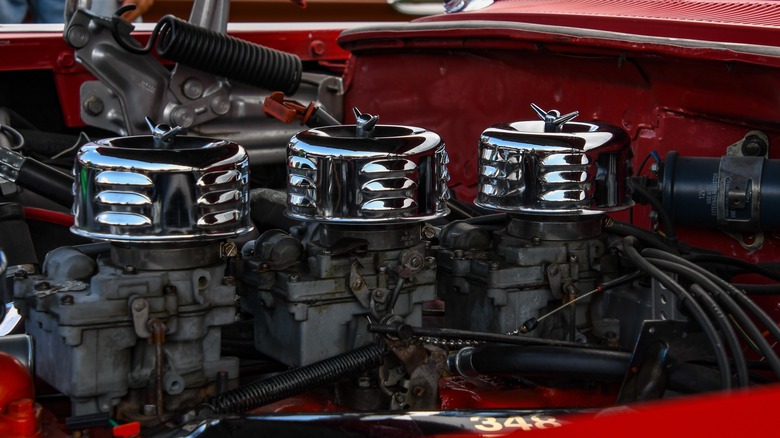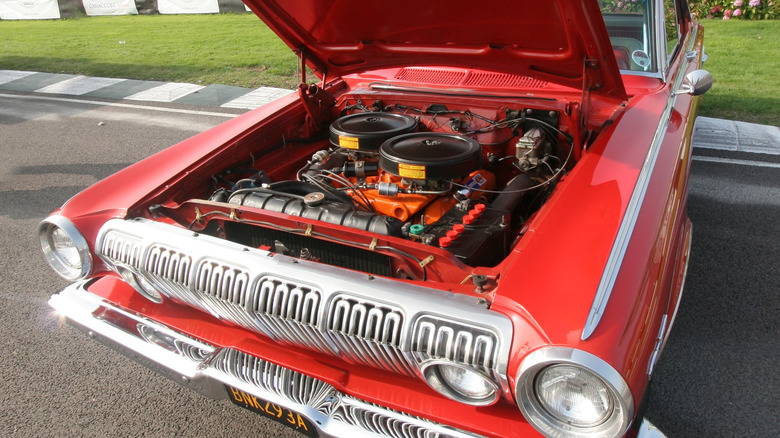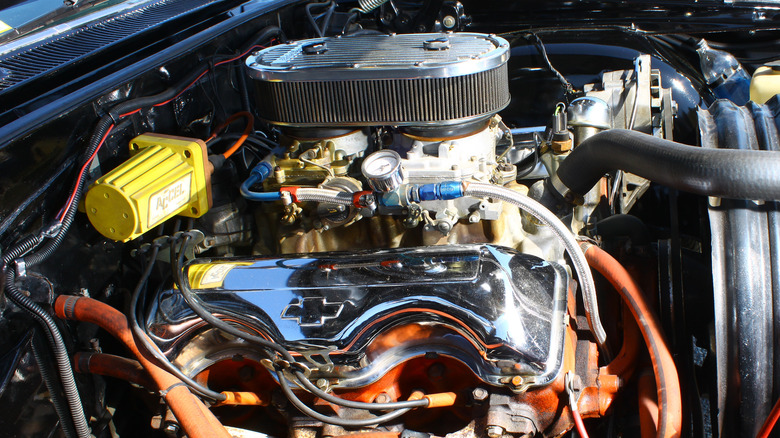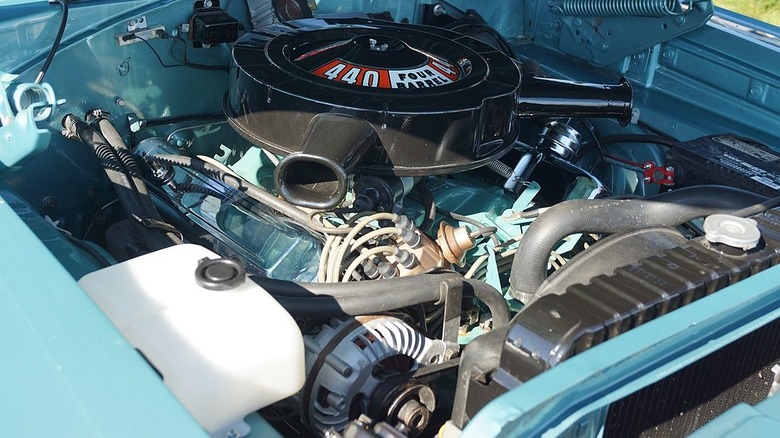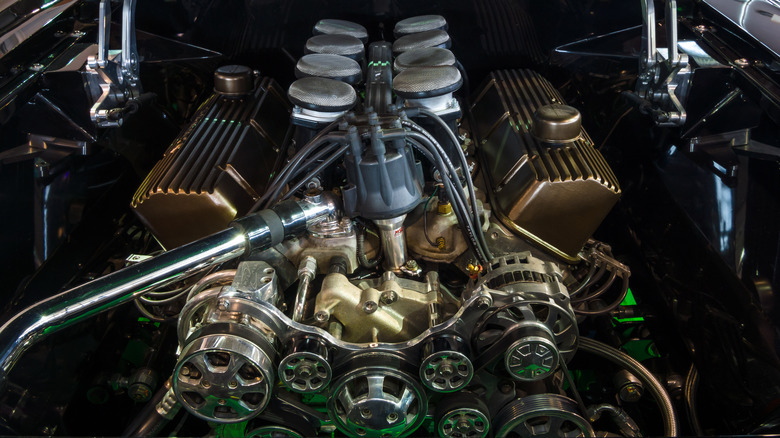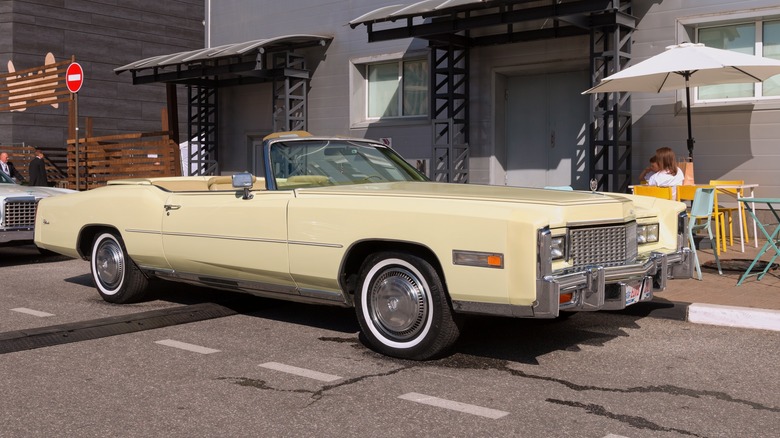5 Big Block Engines To Consider For Your Next Big Restomod Project
Engine development has taken thousands of small steps from the 1850s single-cylinder engine used by Carl Benz in the Patent Motorwagen to the 1,600-hp W16 in the Bugatti Chiron Super Sport.
V8 engines have been an American automotive tradition for more than a century. The first production car to get a V8 was the 1917 D series Chevrolet, and Chevy has made heavy use of V8 architecture since 1955 when it introduced a new 265 cubic inch V8. But the company knew that first small-block V8 wasn't going to be powerful enough to move heavier trucks and got to work on a bigger engine. It took three more years to produce the W-series big block V8, a 348 cubic inch beast dubbed the "Turbo-Trust" even though it was normally aspirated and hadn't earned the trust of anyone other than Chevy engineers by then. The 348 weighed a hefty 625 lbs, and with the triple Rochester two-barrel carburetor setup shown above could produce as much as 350 hp.
Ford and Chrysler also joined the big-block fray and produced some equally impressive engines. If you're restoring an older vehicle, you're going to have a substantial amount of weight to move, and the siren song of a big-block V8's exhaust note will be tempting. Every big-block engine isn't going to work in every car, though. These engines were made for land yachts and trucks, and fitting them in many cars can be a chore. Here are five that pack a punch in a reasonably usable form.
Mopar 418/426 Max Wedge
Chrysler's first-generation Hemi engine debuted in 1951 with a maximum displacement of 392 cubic inches and lived through 1958. The bridge between that engine and the 426 cubic inch second-gen Hemi that appeared in 1964 was the Wedge, which took its name from the shape of its combustion chambers. The Wedge engines were part of the 1959 RB series, a "Raised Block" upgrade from the B series. The first of the taller RB engines was a 413 cubic inch version issued in a Max Wedge form with upgraded internals, new heads, and twin Carter carburetors.
The Max Wedge was made for drivers who wanted to take their cars drag racing, and the 413-inch version appeared in 1962. The otherwise unassuming mid-sized cars in which it was offered were given intimidating names like the Dodge Ramcharger 413 and the Plymouth Sport Fury. A 426 cubic inch Max Wedge was available in 1963 as a $445 upgrade (about $4,600 today) over the standard-issue slant six. That small pile of cash got you up to 425 hp and an engine that inspired the Beach Boys song "Shut Down." Given that they were used in relatively small cars like the Dodge Dart and Plymouth Belvedere, Max Wedge engines are versatile swap candidates. Aftermarket upgrades like fuel injection systems and exhaust headers for these engines are also plentiful.
[Featured image by Brian Snelson via Wikimedia Commons|Cropped and scaled|CC-By 2.0]
Chevy 409
Another engine that inspired a Beach Boys song was Chevrolet's 409 cubic inch big block V8. It took the place of the Turbo-Trust 348 in 1961, with slight increases in bore and stroke creating the extra displacement. As with the 348, the 409's valves were offset and most of the combustion happened in the block instead of the heads. This arrangement and the 409's crowned pistons enabled a remarkable compression ratio of 11.25:1.
GM's engineers added solid lifters and a newly designed hydraulic cam for 1963, boosting output to a remarkable 425 hp and 425 lb-ft of torque. By then, the 409 was available in the Bel Air, Impala, and Chevy trucks, and the 409 and Max Wedge had formed a rivalry on the drag strip and in the Beach Boys song catalog. When hunting your local salvage yard for a 409, look for the distinctive scalloped valve covers and 74-degree block angle. This is one of those engines that requires a sizable bay for installation though, so don't drop it in your Toyota 4Runner. The 409s are best as upgrades in the older cars for which they were originally intended, although you can fit one comfortably under the hood of a first-generation YJ Jeep Wrangler, thanks to its wide frame and generous engine compartment.
Mopar 440
The Mopar RB big-block didn't die out when the second-generation Hemi appeared in 1964. Chrysler's engine team bored out the 413's cylinders to 440 cubic inches and began using it across the Mopar family line in 1966. Chrysler used the triple-carb "six pack" option on some of the era's coolest muscle machines, and this setup made 390 hp and 490 lb-ft of torque.
The 440 hung on through the late 70s and was used in police cruisers, pickup trucks, and RVs, although you don't need a Winnebago to fit a 440. Chrysler's notable big-block V8 was used in European cars like the Iso Grifo and Jensen Interceptor, neither of which had a gargantuan engine bay. The 440 is officially rated at 375 hp, but tuning and upgrades can boost that figure significantly. The wide range of vehicles in which the 440 was used and its long production run make it easy to find in salvage yards, and readily available rebuild kits, cam upgrades, and fuel injection kits will help you get the most out of an old 440 big block.
[Featured image by Greg Gjerdingen via Wikimedia Commons|Cropped and scaled|CC-By 2.0]
Ford 460
Ford's 460 cubic inch big-block V8 rivaled the Mopar 440 for longevity, output, and the variety of vehicles in which it was used. The 460 and its little brother, the 429, premiered in 1968. They were part of the 385 "Lima" series, named for the Ohio plant where they were produced. The 460 was initially used in Lincoln models like the Mark II and Continental, and spread to the Mercury and Ford lines in 1972 and '73, respectively. Around that time, a change in how engine output was reported knocked the 460's official output down to about 200 hp, and it was used exclusively in trucks and vans starting in 1978.
Ten years later, fuel injection helped kick output back up to 245 hp and 400 lb-ft of torque, and the 460 stuck around through 1997. This engine is heavy at 720 pounds and quite long and wide, but its relatively low profile makes it easy to fit under the hoods of many vehicles, from Fox-body Mustangs to Jeep CJ-7s. A 460 can be modified and tuned to produce more than 800 hp, which is massive overkill for a 3,000-lb Fox body. Like the other engines on this list, the Ford 460 enjoys plenty of support for aftermarket replacement parts, upgrades, and tech tips.
Cadillac 500
Cadillac is known more for the luxurious interiors of its cars than the engines that power them, but GM's premier label introduced the overhead valve V8 to the world in 1949. That engine displaced 331 cubic inches and produced 160 hp, an industry best at the time. But by the 1960s, automakers were making much bigger and beefier engines, and Cadillac's cars had grown as well. Cadillac's engineers went back to the drawing board and came out with a fresh engine design in 1968. That 472 cubic inch monster was stroked out from 4.060 inches to 4.304 inches for 1970, yielding an even 500 cubic inches displacement figure. The 500 went under the obscenely long hood of the Eldorado and could produce 400 hp and an utterly ridiculous 550 lb-ft of torque.
The 500 had a short heyday, though. The next few years brought tighter emissions regulations, a required shift to unleaded fuel, and a change from gross to net hp reporting. These developments dropped the 500's output to 190 hp and 360 lb-ft by 1975 when Cadillac started using it in other models. The Caddy 500 weighs about 600 pounds, which seems hefty but is a good deal lighter than its big-block Chevy cousin. You might think this engine will only fit in an Eldorado-sized behemoth, but intrepid (foolhardy?) software engineer Michael Brooks put one into a 1981 Porsche 911 with minimal fuss and fabrication.
